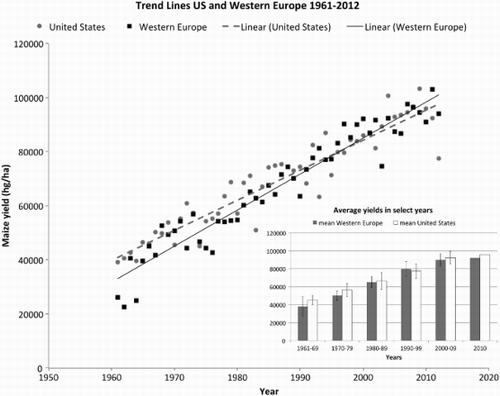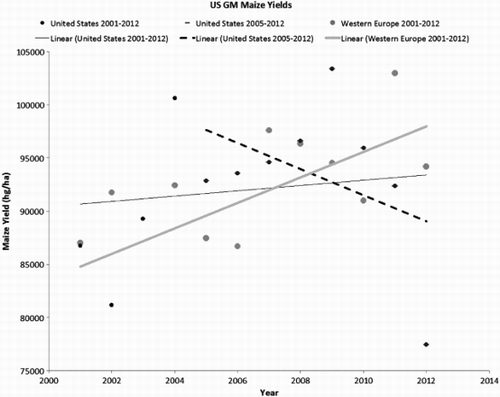Luis Alejandro Apiolaza argues that genetically modified (GM) maize (corn) cropping in the US is producing more maize per hectare than the non-GM maize cropping systems in the six countries which the United Nations Food and Agriculture Organisation defines as ‘Western Europe’ (Heinemann et al. Citation2014). However, his analysis fails to support such a conclusion.
Apiolaza confirms our findings (Heinemann et al. Citation2014) that Western Europe has increased maize yields since 1961 and that its yields were initially lower than those of the US.
He reports the means of yields in the two agroecosytems as a categorical variable by grouping data into arbitrary time periods (e.g. 1961–1969 = 9 years; 2000–2009 = 10 years; 2010 = 1 year). We instead minimized bias by presenting the complete data set for the entire 50-year period as a continuous variable ().
Figure 1. Yield trends in two agroecosystems. Since our last paper, FAOSTAT has published 2011 and 2012 yield data for both the US and Western Europe. US yields continue to be lower compared to those of Western Europe. Inset: reconstruction of from Apiolaza including a measure of variance.

Apiolaza did not report variability in the annual yield data. In the time period that Apiolaza highlights as having significant GM maize production and higher average yields in the US compared to Western Europe (2000–2009), the means between the two regions are statistically indistinguishable, as is true for all his sets of comparisons (inset, ). There is no statistically significant difference in the means over the entire 50-year period (Heinemann et al. Citation2014). However, increases in yield over the 50-year period were significantly different between the US and Western Europe.
In addition to excluding the other two crop types we discussed (Heinemann et al. Citation2014), Apiolaza excluded 2011–2012 data on corn, which is available now, because of the drought in the US. Droughts occur regularly and to selectively exclude one drought in one agroecosystem is a bias.
Using the complete data set of 50 years of comparative yield data in two different cropping systems (maize and oilseed rape), we could demonstrate no significant positive contribution from GM to yield.
Focusing only on the years of significant GM maize cropping in the US, as Dr Apiolaza suggests, further confirms our findings (). The US produced 90% of all the GM maize it has ever grown between 2001 and 2012, and 75% between just 2005 and 2012. Over 50% of the annual maize crop has been GM since 2005, and between 80% and 88% since 2008 (USDA Citation2013). When we consider the period 2001–2012, annual yields were similar across years (y = 248.8x − 407,204). In contrast, Western Europe yields increased more than five times the US rate (y = 1198.3x − 2e06) despite a significant drought in 2003 in Western Europe. In the eight years (2005–2012) during which 75% of all GM maize in the US had been grown, yield actually declined (y = −1227.7x + 3e06) but yields were increasing in Western Europe (y = 2521x − 5e6). In other words, if we were to concentrate only on the period when the US was growing essentially all its GM maize, we would find that the yields were decreasing or static, while Western Europe's yields increased significantly over this same period. Hence our argument that GM did not contribute significantly to yield increases in the US holds.
Further, the fragility of the small data set, the one suggested by Apiolaza corresponding to the GM maize growing period in the US, is shown by how much the slope of the regression line changes by the addition of even a single year. Consider the US yield data over a series differing by one year during the period when the US produced 90% of all the GM maize harvested to date (beginning in 2001). The regression from 2001 to 2010 was y = 1560x − 3e06 and the slope decreased 28% when the data set was extended to include 2011. The regression from 2001 to 2011 was y = 1119.8x − 2e06 and the slope decreased another 78% when the data set was extended further to include 2012 (y = 248.8x − 407,204).
In contrast, the addition of single-year increments out to 2012 has little effect on our original 50-year data set (). The regression line for US yields from 1961 to 2012 is y = 1112.4x − 2e06; from 1961 to 2011 is y = 1159.8x − 2e06; and from 1961 to 2010 is y = 1173.8x − 2e06. The slope changes −1.2% adding yields from 2011 and −4.1% from 2011 to 2012 (the year of the great drought). The 1961–2012 regression line for Western Europe (y = 1332.1x − 3e06) has further diverged from the US regression line with the addition of 2011 and 2012 yield data, as we predicted (Heinemann et al. Citation2014). The direction of the yield changes is consistent with our observation that there has been no obvious comparative yield benefit from the adoption of GM crops in the US compared to the biotechnologies in use in Western Europe.
Figure 2. During the period of greatest concentration of GM in the US agroecosystem, yields have been static or declining compared to Western Europe.

Apiolaza then suggests incorrectly that we have assumed that North America and Western Europe have ‘the same intrinsic yield’. He argues that the US has lower maximum intrinsic yields than Western Europe, and this difference explains the lower yield gains relative to Western Europe. We presented the alternative possibility that the US agroecosystem is operating further below its maximum attainable yields than is Western Europe, which is supported by research showing that Western Europe is performing more closely to its maximum yield than is the US (Licker et al. Citation2010). We argue that the US still has the possibility to increase annual yields. It has, however, not made the choices that result in it achieving its full yield potential. This argument is further strengthened by the fact that Western Europe has higher yield gains in wheat and oilseed rape, not just higher yields than the US and Canada, respectively.
The second issue is that Apiolaza speculates that lower yields in the US are due to land being cheaper than additional inputs, for example, of pesticide and fertilizer, and the opposite is true for Western Europe. That argument is interesting. However, we are unaware of comprehensive evidence demonstrating that the Western European farmers are using more expensive inputs than US farmers. According to the latest FAOSTAT data, for example, Western Europe uses more nitrogen than the US, but it is decreasing its use while the US is not. Western Europe now uses less phosphorus per area than the US and is decreasing its use while the US is not. The trends are similar for pesticides (Heinemann et al. Citation2014). In any case, if expansion onto cheap but marginal land explains the US's relative inefficiency, this only supports our conclusion that the larger policy context of the agroecosystem must be considered when choosing a biotechnology pathway. As land becomes limiting for agriculture, inefficient practices will not be economically sustainable. The US will still need biotechnology options that improve yield on all agricultural lands. In this way, Western Europe has perhaps provided some insights into how the US might transition to a higher yield agroecosystem.
Finally, we agree with Apiolaza that a careful analysis of pesticide use and its impact on yield would be useful, if comprehensive data on pesticide use by type, crop acreage, and country were available.
The conclusion we drew in our paper (Heinemann et al. Citation2014) was that GM crops of the kind in use are not the problem: they are a symptom of a long-term policy in North America that is not as effective as possible at advancing a biotechnology package that both increases yield and reduces pesticide use – characteristics of a future agriculture that we all want.
References
- Heinemann, J.A., et al., 2014. Sustainability and innovation in staple crop production in the US Midwest. International journal of agricultural sustainability, 12 (1), 71–88. doi: 10.1080/14735903.2013.806408
- Licker, R., et al., 2010. Mind the gap: how do climate and agricultural management explain the ‘yield gap’ of croplands around the world? Global ecology and biogeography, 19 (6), 769–782. doi: 10.1111/j.1466-8238.2010.00563.x
- USDA. 2013 Adoption of genetically engineered crops in the U.S. National Agricultural Statistics Service NASS. [online]. Available from: http://www.ers.usda.gov/data-products/adoption-of-genetically-engineered-crops-in-the-us.aspx#.UqJCT-vMpU8 [Accessed 7 December 2013].
